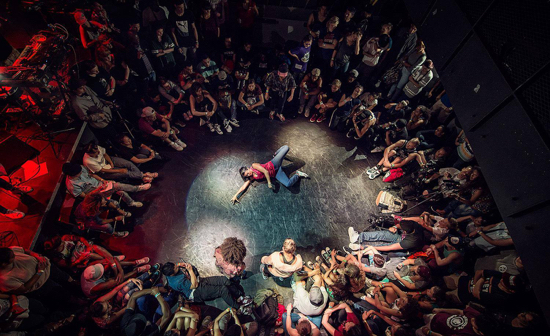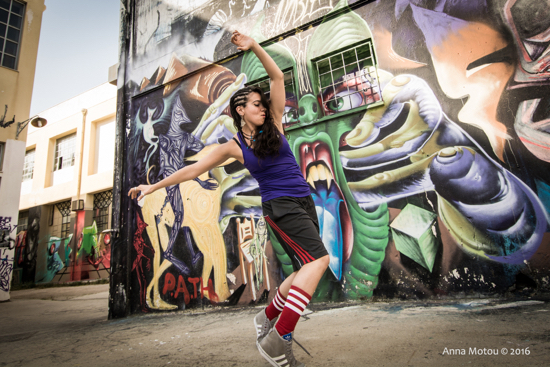
I’m so pleased to be able to bring you an article on a topic we don’t hear too much about in the dance medicine world – Breaking – or “Breakdancing” as it is often referred to in the media – and how it affects the dancer. Nefeli Tsiouti Is a young IADMS (International Association for Dance Medicine and Science) member from Cyprus, who has brought the art form forward, bringing knowledge and understanding to the injuries suffered in this field. She graduated from Trinity Laban Conservatoire of Music and Dance (London) with her Master’s in Dance Science less than 3 years ago, and already has done much to further her passion about Breaking and concern about the dancers’ wellbeing. She is the founder and Director of Project Breakalign, drawing attention to this topic worldwide. She is also a researcher for the Cyprus Musculoskeletal and Sports Trauma Research Center, and is currently pursuing her Physiotherapy degree at European University, Cyprus. Nefefi won the Sports Therapist of the Year award from the international Federation of Holistic Therapists. She has an impressive resume already, and we will be hearing much more from her in the future. Please pass this on to all of your dancers / teaching colleagues, but especially those who work in this particular dance form.
– Jan Dunn, MS, Dance Wellness Editor
by Nefeli Tsiouti, MA, MSc
I will not stop writing articles until I can get all hip-hop dancers away from injury!
Psychologists say that if you have experienced a situation yourself, you are more equipped to relate better and help others who will go through similar situations. So here I am, after overcoming severe chronic injuries, some of which have not yet decided to fully go away, and some surgical experiences, I have decided to dedicate my life to helping others prevent injuries.
Dance gave me wings, as it does to everyone. But one day, when I met ‘Breaking’ (or Breakdance as known by the media), I was amazed! A very intriguing, social, upside-down, flipping around, creative dance style that offers creativity beyond the roof. It is literally one of the most uplifting and open-to-options dance forms that one can get involved with.
However, as positively unique as Breaking may be, because of the extreme physicality that is required to be able to perform it, if it is not taught progressively, and without the appropriate body conditioning, it may cause injuries to the body.

A big part of the mentality of a Bboy/Bgirl (Break-boy /Break-girl, the male or female who dances to the ‘break’ of a song – otherwise known as Breaker / breakdancer) is the constant fight to achieve. Bboys and bgirls set very high goals when practising their art form, and with that also comes managing an injury and dancing through it. They prefer to dance with an injury and keep developing, than to stop practising in order to rest and heal–and then return to dance.
This preference to continue while injured, was one of the answers dancers gave on the 1st global Breaking survey I conducted with Dr. Matt Wyon (University of Wolverhampton – UK), on injury occurrence in Breaking. They stated that it was preferable to ‘continue dancing with the injury, but carefully’. From my perspective, this hunger and drive to become better than yourself every single day, and to always develop, is one of the most beautiful and rewarding elements of Breaking. The hard work that Breakers put in their craft, and the reward they feel when achieving their goal, when winning the battle, when completing their move, when spinning on that head, when landing properly on that elbow – all the crazy things that once looked supernatural, become systematic in their practice.
Generally, in Breaking the most common injuries occur on the upper body. The axis of the body is very often vertical in Breaking, therefore the impact on the joints and the demands for the upper body to generate the movement, is very high – but also unnatural, in terms of principles of functional movement as well as ‘typical’ ways of moving. A study that we conducted at the Institute of Sport, Exercise & Health at UCL (2015), showed that not only does fatigue have a significant negative impact on the stability of specific foundational breaking movements, but it can also reduce the force which breakers use to get into certain movements. This finding suggests that fatigue may lead to injuries – in relation to pressure and weight distribution. However, the more fit and in better condition the breaker is, the less likely it is that they will get injured [1].

It is essential to not put obstacles into this positive community of people who have built great skills out of nothing. In 2013, when I realised how broken I had become from dancing (18 years of dancing at the time), I decided to act on it and contribute to the hip-hop culture in a way that others hadn’t had the chance to do at that point.
Therefore, in 2013 I started a research project on the prevention of injuries in the breaking field – Project Breakalign. What we have concluded is that there is something missing for the breakers, and generally for many dancers in other forms as well. That missing ingredient is a tool…..A tool for dancers to educate themselves and embody in their body – i.e, the necessary information for prevention of injuries. My research team of 15 international researchers/dancers, and myself, conducted a 1.5 year-long project where we created the Breakalign Method. This is a conditioning program, based on the analysis of the biomechanical (meaning the mechanics of movement) and physiological demands of Breaking. More information on the Method and the project can be found at: www.projectbreakalign.com . The creation of the methodology was funded by the Centre National de la Danse, in France.
But, a moment of honesty is necessary here. Preventing injury in such a physical group of dancers may be done up to a certain point. From that point onwards, as dance scientists and researchers of the genre, we can reduce the risk of injury by implementing certain principles in the practice of Breaking – but the risk will always be there, depending on the spontaneity of the dancer, their fitness level, the flooring, their shoes, and many more elements…..that I could talk about for hours!
So this concludes this first introduction to Break Dancers and Dance Medicine / Wellness –stay tuned for #2 article, coming soon on 4dancers.org.
References: [1] Tsiouti, N., Constantinou T., Philip, K., Sanchez, E., Paton, B. (2016). Evaluating the relationship between fatigue, pressure and weight distribution on the upper limb in breakers. Revista Movimenta. 9(4): 659-664. (http://www.revista.ueg.br/index.php/movimenta/article/view/5622/3840)

Nefeli Tsiouti completed her MSc in Dance Science, supported by 3 scholarships from Trinity Laban Conservatoire of Music and Dance in London. She has been dancing for 21 years, having as her main dance training classical ballet in Cyprus and Greece. She has obtained a Bachelors Degree in French Language and Literature from the University of Athens in 2009 and a Masters in Choreography from Middlesex University in 2011. She has been a Lecturer in Dance in Colleges and Universities across London since 2011. She is also the Artistic Director of Scope Dance Theatre since 2010, making hip-hop dance theatre using the artistic elements of the hip-hop culture.
Nefeli initially began training Breaking in 2007 and unfortunately obtained a very serious injury on her shoulder, which meant she had to stop any physical activity and have a medical operation in 2008. Several years after no dance activity, she moved to UK for her studies and began Breaking again and has been competing nationally and internationally ever since. Since 2013 she has been the Founder and director of ‘Project Breakalign’, a prevention of injuries research project for breakers. The aim of the project is to bridge the gap between dance medicine and science, and dancers, and to make the knowledge of research become as applicable as possible to the hip-hop dancers, and not only.
Nefeli won the Lisa Ullmann Travelling Scholarship Fund in 2014, choosing New York as her research destination. She was also awarded the Bogliasco Foundation Fellowship in 2015 in Genoa Italy for further research on injuries in breakers. She has also been awarded the Gill Clarke Resource Fund, the ‘Centre National de la Danse’ Funding in 2015 to develop the ‘Breakalign Method’ for Project Breakalign, the ‘Dance UK’s Dancers’ Mentoring Programme’, being mentored by Matthew Wyon, as well as being a finalist for the ‘Change Maker Award’ by London Inspires Awards.
Nefeli’s work over the past few years has focused on developing a new area of dance medicine and science research, which focuses on hip-hop dancer and specifically breakers. Project Breakalign has been at the forefront of bringing new information to academic research and translating it to reach the communities with the dancers who need it. Nefeli has devoted her work to the mission of reducing the risk of injuries and promoting a healthier dancer for longer, with Project Breakalign’s research, lectures, workshops and her active participation in international breaking competitions.
International speaking engagements include Brazil-UK Network in Dance Medicine & Science 2016 in Brazil, Performing Arts Medicine Association’s Annual Conference 2016 in L.A., Healthy Dancer Canada 9th Annual Conference 2016 in Saskatoon, International Association for Dance Medicine & Science Annual Conference 2016 in Hong Kong, Serendipity’s Blurring Boundaries: Urban street meets contemporary dance 2015 in De Montfort University UK, Kingston University’s PoP Moves Emerging Scholars Symposium 2012 in UK and Goldsmith’s University’ Conference of Contemporary Music & Dance 2012 in UK. In 2017, she will present the creation process of the ‘Breakalign Method’ at the Centre National de la Danse in France. For more info, watch the following trailer: https://youtu.be/zJjSoo6WAic
Nefeli’s professional performance and/or choreographic credits include London Olympics Opening Ceremony 2012, RIOT Offspring/Sadler’s Wells 2014, Open Art Surgery/Breakin’ Convention, Dance Umbrella/Barbican, B.Supreme UK Tour, Faraday’s Cage film/Company Bricolage, Barcelona International Dance Exchange, The Place, ELLE-Adidas MyGirl Global campaign 2014, Folk Dance
Remixed UK Tour (2014-15), Opera in Revolution 2015 in Cyprus, and more.
Published articles include a piece of research in Blurring Boundaries: Urban street meets contemporary dance by Serendipity (2016) and also an article about health in dance in Dance Today. Dancing Times (2014). More publications are expected from 2017.
Tsiouti, N., Constantinou, T., Philip K., Sanchez, E. & Paton, B. (2016). Evaluating the relationship between fatigue, pressure and weight distribution on the upper limb in breakers. Revista Movimenta. 9(4): 659-664




